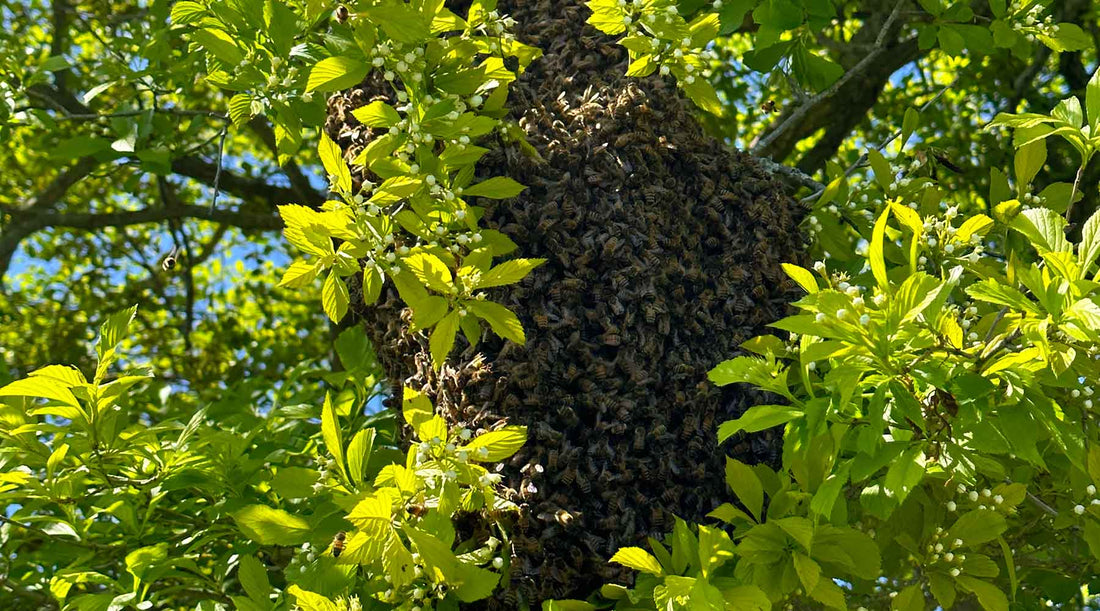For the average person, running into a swarm of bees can be pretty disconcerting. A cluster of buzzing insects is alarming after all, and it can feel like something must have gone horribly wrong for it to happen. But swarming is actually a sign of a healthy bee colony. Here’s why bees swarm, and what to do if you encounter one.
What is a swarm of bees?
A swarm of bees is a large grouping of the insects outside of the nest. Swarming is what bees do when they’re on the hunt for another home. As a few members of the colony scout out locations for this new dwelling, the rest of the bees wait for them in a large grouping on a tree, building, or other convenient spot. Bee swarms aren’t permanent, and once they’ve found a suitable new home, they’ll move in.
Why do bees swarm?
Swarming is a natural behaviour, and bee colonies do it for a few different reasons. The first and most common reason that bee colonies swarm is due to population levels. A healthy bee colony with abundant food sources can produce a significant number of bees. While this level of reproduction is beneficial, it also means that the colony will eventually outgrow its hive. Rather than add on to their dwelling or abandon it entirely, part of the colony will leave with the queen.
When they vacate their old hive, the swarm doesn’t have a destination in mind. Instead, they settle in a large grouping, waiting for scouts to return with a suitable location. Once they do, the swarm departs for this new home and begins the process of turning it into a hive.
The queen’s pheromones drive the swarming behaviour, and the workers flock to her as she leaves the hive to swarm. If she dies or isn’t able to fly, the bees will return to the hive instead of decamping.
As for the bees that stay behind, they aren’t left queenless — at least not for long. Swarming is an instinctive practice for bees, and they know when it’s about to take place. In the lead up to it, the colony prepares by laying the groundwork for a new queen.
To do this, the worker bees make a number of special cells, built to house future royalty. Then, these aptly-named queen cups are filled with eggs and royal jelly. Once they hatch, the larvae in these cells continue to be fed royal jelly exclusively, instead of being weaned off of it after three days. This small dietary change remakes their respective destinies, allowing them to emerge as queens instead of industrious worker bees.
The bees rear a number of these replacement queens to hedge their bets and ensure they’re able to replenish their ranks. But a colony can only have one queen. Accordingly, the first to hatch will typically seek out the other developing queens and sting them to death in their cells before they have a chance to emerge and compete with her.
In some instances, new queens may hatch and precipitate another, smaller swarm after the primary one. As this new queen leaves with more of the hive to establish her own offshoot nest, one of the “extra” queens becomes the colony’s new leader. While it may be annoying for beekeepers, frequent swarming is usually a sign of a healthy colony.
Do unhealthy bee colonies swarm too?
Not every swarm comes from a colony that’s doing well. While it’s primarily a function of reproduction, swarming can also be useful for culling members of the colony that are infected with a pathogen.
Swarming is a stressful undertaking for the bees who leave as they’re without shelter or food, sometimes for several days. And, depending on where they establish a new hive, they may have to fly long distances. Members who have been weakened by a virus or other pathogen are less likely to survive this process.
For example, a particularly bad parasitic infestation with varroa mites may spur bees to swarm. While varroa mites parasitize adult bees, they reproduce alongside bee larvae in the honeycomb cells. Since swarming removes a large number of adult bees from the hive and then results in a period of time where they aren’t reproducing (while they find and build a new hive), it can significantly curtail a varroa mite infestation.
Bees will also swarm to seek out food or a better environment. If their current location lacks resources or is problematic in some way — such as a skunk ravaging their nest — honey bees may swarm to move the colony to a better location.
How long does a swarm last?
Healthy swarming is an innate bee behaviour meant to split the colony into two. This often makes it resource-dependent, and more likely to happen when the colony can access enough food to flourish. Because of this, the timing of a bee swarm is fairly predictable. Swarming usually happens in late spring and early summer when food is plentiful and the weather is good enough to be outdoors for a while. Establishing a new home at this time of year also allows the bees to build up the stores they need to survive winter.
How can you tell that a bee colony is preparing to swarm?
In preparation for swarming, worker bees will stop feeding their queen for a few days. As a result, her body weight will decrease between ⅓ to ½, which ensures she’s light enough to make the journey to their next home. Workers, in contrast, gorge themselves on honey during the lead up to store the energy they’ll need for the trip.
Noticing that the queen has lost some weight or that the other members of the colony have bulked up can be hard to see. However, beekeepers can often tell that a colony is preparing to swarm by looking at their honeycomb. A large number of bees is a good indication that the colony is going to break in two. So too, if almost all the honeycomb cells are full of honey, nectar, or growing baby bees.
But one of the most telltale signs that a swarm is going to take place is the appearance of peanut-shaped cells around the edges of the comb. These are queen cups, also known as queen cells. These can be made either in preparation for a swarm or to requeen a queenless colony, for example, if a queen dies or is underperforming, and indicate that the colony is preparing to replace their head of state. Coupled with a robust population that’s run out of space, this is an almost undeniable indication that the bees are planning a swarm.
Can beekeepers prevent swarming?
Many beekeepers try to prevent swarming to avoid losing bees. To do this, they’ll employ a few different methods. One that's generally discouraged is to clip one of the queen’s wings. This prevents her from flying, and, since bees won’t swarm without a queen, it lowers the risk of it happening — at least in the near term.
At Kinghaven Farms, we adhere to ethical beekeeping practices that prioritize the preservation of natural bee behaviour to the greatest extent possible. The most effective method of preventing swarming is called splitting, which effectively means dividing the colony into two smaller hives.
To do this, the beekeeper removes some of the frames from the hive that’s getting too big and places them into the new hive. The frames they choose will contain brood (eggs and developing larvae) as well as honey, nectar and pollen. A queen or queen cell/swarm cell is also placed into the hive, and some workers and nurse bees are added as well.
This tactic leaves the old colony under the impression that they’ve already experienced a swarm, leaving them to either rear a new queen or ready to have a new one introduced to them.
Are bee swarms dangerous?
It may seem counterintuitive, but bees are at their least dangerous when they’re swarming. Because they’ve left their home, their brood, and their reserves of honey, they’re not worried about protecting anything. In this state, they’re unlikely to be aggressive. However, this doesn’t mean you should get close. It’s best to leave a swarm of bees alone unless you’re a trained beekeeper.

What to do if you encounter a swarm of bees
1. Stay back. While swarms aren’t aggressive, if they feel threatened, they’re just as likely to sting as other bees.
2. Don’t try to move the swarm. They’ll be on their way once they find a new suitable location, usually within a day or so.
3. Don’t spray the bees with water, insecticide, or try to get rid of them yourself.
4. If you do need to move the bees — if they’re in a playground or you’re anaphylactically allergic — reach out to your local apiary inspector who may be able to find a beekeeper who can relocate them. Or, if you’re in York Region, contact us and we’ll gladly help with safe swarm removal.
Before you do though, please make sure that it’s actually a colony of bees. Other bee-like insects like wasps also swarm, and many tend to be much more aggressive than honeybees. If you’re not sure what species you’re dealing with, snap a pic if you can and we can help you identify it. And, as always, approach any swarm with caution.

